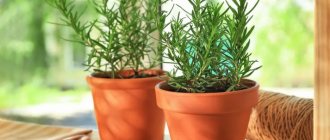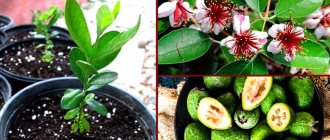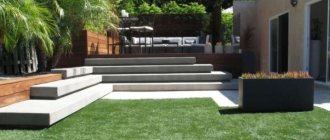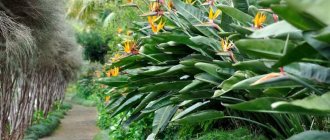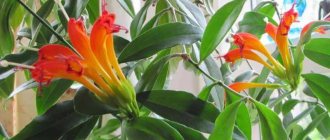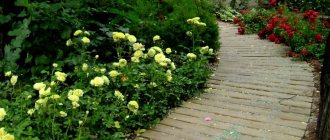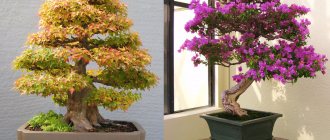Bamboo is an unusual plant that is neither a shrub nor a tree. Giant grass in its natural growing conditions reaches a height of 30-40 meters. In nature, you can no longer find another plant that has such a high growth rate. Bamboo shoots grow up to 20 centimeters per day. This phenomenon is observed only in the wild. At home, culture develops much more slowly. In our article we want to talk about how to grow bamboo at home.
Home plant
Not everyone knows that indoor bamboo is not related to the bamboo that grows in the wild. At home, we grow one of the varieties of a very popular crop - dracaena, or, to be more precise, Dracaena Sander.
The plant is a bare stem with several leaves at the top. The trunk can be straight or bent in a spiral. Typically, indoor bamboo is painted bright green. Sometimes there are golden-colored plants. If the crop is exposed to bright sun during the day, its color becomes dark green.
Many gardeners ask the question: “Is it possible to grow bamboo at home?” After all, it is considered a plant that brings good luck and happiness. Apparently, for this reason the plant is popular. If you place bamboo in the southeastern part of the house, you will certainly be blessed with good luck and financial stability.
Types and varieties of bamboo
Among the many types, several are the most popular:
- Sasa is grown in Japanese gardens; there are dwarf and long-growing varieties, the height of the stems is from 25 cm to 2.5 meters. The leaves of Kuril saz are up to 13 cm long and reach 25 mm wide. Saza Nebulosa resembles a palm tree, the Vichi variety has a golden hue.
- Fargesia or Chinese bamboo is a group of medium-sized plants. The length of the sheet plates is up to 10 cm, width is up to 15 mm.
Up to 40 types of fargesia have been sectioned for home cultivation and winter gardens:
- The brilliant one tolerates frosts well, overwinters painlessly in open ground, and when the stems become lignified, they acquire a pleasant dark brown color;
- The New Collection is valued for its exterior: a dark cherry trunk with a purple tint contrasts with lush greenery;
- McClue grows up to 3.5 meters high, the variety is used for linear plantings, camouflaging fences, trellises;
- Eisenach, Great Wall - varieties of bamboo with small thin dark green leaves, these varieties are used to create hedges;
- Simba, Jumbo, Bimbo are low-growing varieties for indoor growing.
Phyllostachys is a tall type of bamboo with short internodes, flattened or grooved colored stems:
- black (stems begin to darken after two years of growth);
- with golden grooves and purple thickenings;
- light blue, exotic color begins to appear when the shoot becomes stiff in the second year of life, this heat-loving variety is used in landscape design;
- green, not all varieties of bamboo change the color of the stem during growth;
- yellow-brown, this contrast traditional for bamboo is often combined with a different shade of internodes.
Pleioblastus are dwarf varieties, among which there are variegated ones. The shrub is suitable for home growing.
Growing Bamboo
How to grow bamboo at home? It is best to place the plant on an east window. Direct sunlight must be avoided. Despite the fact that the crop is light-loving, too intense lighting can cause burns on it. In addition, dracaena does not tolerate drafts. Ventilation in winter can lead to the death of the plant. In the summer, bamboo needs frequent watering and careful attention to ensure that the soil does not dry out. In winter, moisture should be more moderate.
If you notice that the plant is losing its leaves, you need to increase the light. The tallest plants should be planted in large pots, which can later be placed in a place with diffused light. It is necessary to monitor air humidity. Dracaena does not feel very comfortable in a room with dry air.
Caring for indoor bamboo at home
Growing indoor bamboo is in many ways similar to cultivating it in open ground. For convenience, the care algorithm is summarized in a table.
| Factor | Description |
| Location and lighting | Florists recommend placing bamboo on windows facing east or west; diffused light will be provided by a mesh curtain. If there is not enough sun, the plant will shed its leaves. |
| Temperature | The optimal growth regime is from +18 to 25 °C; the shrub tolerates high temperatures on summer days without stress; a sharp difference between night and day temperatures is undesirable. |
| Priming | Bamboo is not fussy; soil for any flowers, melons, tomatoes, or universal soil is suitable for it. Drainage is placed at the bottom when planting. |
| Capacity | It is advisable to choose a clay pot so that it can breathe. It is important to immediately choose a deep and wide container; the plant needs space. |
| Watering | The earthen lump should not dry out; it is moistened as it dries. Young shoots are watered abundantly only in the first month of growth. In winter, it is important to avoid stagnation of water. |
| Humidity | It is advisable to wipe bamboo leaves weekly to prevent dust from accumulating on them. Wet spraying is carried out infrequently; only in the evenings after hot days is the plant allowed to rest from the heat. |
| Top dressing | The whole complex of minerals and organic matter is required. It is advisable to choose fertilizers for dracaenas; if they are not available, it is permissible to use universal Agricola for indoor plants. |
Growing in water
How to grow bamboo at home in water? If you purchased bamboo, you can try placing it in a container of water. The dracaena roots are washed well, inspecting them for damage. Rotten areas must be removed. Settled or distilled water is poured into the container and the plant is lowered into it, securing it with beautiful pebbles, previously boiled (for disinfection).
In the future, the liquid in the vase must be changed every 14 days. If the water becomes cloudy before the appointed time, it must be replaced. Once a month, the crop is fed with fertilizers for dracaenas.
Features of care in winter
- In winter, the air in a heated room is drier, and in order for the plant to tolerate this more easily, watering is reduced.
- Due to the dry air, it is recommended to keep bamboo away from heating appliances.
- Hypothermia also has a bad effect on the well-being of the “lucky bamboo”, so you should move it from the window sills, and when ventilating the room, protect it from drafts.
- In prolonged cloudy weather, it will not be superfluous to additionally illuminate the plant with fluorescent lamps. Especially if the leaves drooped and began to fall off, and the trunk turned yellow.
Landing in the ground
How to grow bamboo at home? The plant feels very comfortable in a pot with soil. For planting, you need to choose a spacious container so that the roots are not crowded. Expanded clay should be poured onto the bottom of the pot as drainage. For planting, you need to purchase special soil for dracaenas. It is sold in specialized stores.
How to grow bamboo at home? The composition of the soil for growing dracaena is quite simple. If you were unable to purchase a ready-made substrate, you can prepare it yourself. To do this, you need to mix one part peat, part humus and two parts clay turf. Dracaena is transplanted into a new container no more than once a year. Older plants are replanted once every three years. Bamboo is fertilized twice a month.
How to transplant
The growth of the root system of bamboo occurs quickly, so planting should be done annually. This is best done in the spring. For subsequent transplants, you need to take an even larger pot. The container should be moderately wide and deep, so that the distance from the edge of the pot to the stems is at least 5 cm.
When dividing the bush, make sure that the root system is sufficiently developed. Try not to damage the rhizome.
The soil mixture used for replanting includes:
- 1 part humus;
- 1 part peat;
- 2 parts clay turf soil.
Don't forget to put drainage on the bottom. A newly transplanted plant needs proper maintenance, combining good watering and fertilizing.
Plant rejuvenation
Bamboo grows quickly, and the leaves need to be trimmed to prevent the plant from acquiring a shapeless and neglected appearance. Old leaves can be cut off completely. The cut areas are treated with charcoal powder. The crop is pruned to remove wilted, dead, diseased leaves, as well as to rest the plant.
Rejuvenation of bamboo requires subsequent care, including abundant watering, good lighting, fairly humid air, and high temperature. Pruning can stimulate the crop and accelerate its growth.
Growing in hydrogel
Bamboo can be grown in hydrogel. This method is the least common. The plant is placed in a container, which is filled with water and hydrogel. As the capsule is used, the substances gradually change their shape and color.
Such cultivation does not cause much trouble for the gardener. Fresh water must be added to the vessel as needed. In addition, dracaena is fertilized twice a month.
Use for interior decoration
Indoor jasmine - home care
Household bamboo is widely used in interior decoration. Its presence in the interior allows you to create a tropical atmosphere. Using tools to change the shape of the stems allows you to create various natural patterns.
Additional Information. To create a romantic atmosphere, designers recommend placing candles next to bamboo stems. It's safe and very unusual.
Bamboo propagation
Bamboo is propagated in several ways: cuttings and root division. The last method is good if you are planning to replant the plant. Large shoots can be separated from an adult plant, which can be immediately planted in the ground. At first, the seedling needs to be watered frequently.
How to grow bamboo at home from cuttings? To root a young plant, you can place it in a container of water. It is difficult to say how quickly roots will appear on the cuttings: it may take a month or six months. Don't rush bamboo. He will give roots at the right time. Some gardeners place the cuttings in a wide container of water so that they float on the surface of the liquid. After the roots appear, the plants are planted in the ground. This method is very convenient. Young plants do not need bright light, so they need to be shaded a little.
Sometimes gardeners are interested in how to grow bamboo at home from seeds. In flower shops you can see bags of crop seed material. However, experienced specialists do not recommend purchasing them. It is almost impossible to grow dracaena from seeds. This method is not used in practice.
Features and methods of reproduction
If you already have one pot of indoor bamboo in your house and you need to propagate it, you can do this in several ways. In this case, many factors are taken into account that influence the further development of the plant. You can also use the seed propagation method. But most often they resort to the method of increasing plantings by separating shoots from an adult healthy sample. The method is simple, does not require any extra knowledge or skills, and can be successfully implemented at home.
Cuttings, in turn, are divided into several more types:
- apical;
- stem;
- knees.
The apical cutting method is performed by cutting a 15 cm long apex from the mother stem. The cut part is placed in water, a growth stimulator is added and the roots are waited for. To prevent stem rotting, all cut areas are lubricated with liquid wax.
With the stem cutting method, root development also occurs in water with a growth stimulator. The adult stem is cut into pieces and processed. This method of reproduction is used when the previous one failed.
Reproduction by knees is not a particularly popular method, despite its effectiveness. It is used if an old plant with a weakened root system needs saving. The stem is placed in water. When measles begin to appear at the junction of the segments, this part is separated from the general shoot and transplanted into the ground.
Seed propagation of indoor bamboo is a simple technique. Suitable for woody varieties. Planting material is purchased at any specialized store. It is soaked for 12 hours in clean water to swell. At this time, the soil is prepared. Mix fine wood shavings with soil in a ratio of 1:8. One part of wood ash is also added there.
The substrate is sifted, moistened and poured into containers. In each, make a depression of about 4 cm and place one seed there. The seeds must first be dried with a paper towel and left for 15 minutes to dry naturally. As many seeds as you decide to plant, so many containers need to be prepared.
The crops are covered with substrate, and the containers are placed in partial shade. Until the first shoots appear, maintain a sufficient level of soil moisture. From the moment of planting until the shoots appear, at least 2 weeks must pass. Sometimes the process stretches out to almost a month.
Fertilizer feeding
Whatever growing method you choose, bamboo needs to be fertilized regularly. For this, organic and mineral fertilizers are usually used. Specialized fertilizers for dracaena can be purchased at flower shops. Their advantage is that they contain a complete set of elements necessary for plants.
During the cold season, fertilizing is carried out several times a month. In summer, it is enough to apply fertilizer once every three weeks. If you notice that a houseplant is growing too slowly, then this is a reason to think about the need for fertilizing.
Experienced gardeners recommend giving preference to growing bamboo in the ground. The plant can survive in water for a year or more. Its lifespan depends on the quality of care. Sooner or later, the bamboo disappears in the water. Therefore, it is better to plant it in the ground so that the crop will please you with its decorative effect longer.
Selecting a site and preparing for transplantation
Before transplanting, you need to prepare everything you need. To do this you will need: a planting container, soil, drainage material, and a means for rooting the flower.
The choice of location also needs to be approached carefully. Bamboo came to us from tropical forests, where the climate is humid and warm. Therefore, a bamboo indoor plant will do well in a warm and well-lit corner. He only needs diffused light; light partial shade is also suitable. The most comfortable temperature is considered to be from 20 to 25 degrees. In the room where bamboo grows, the air should not stagnate.
Getting plants from sticks
How to grow bamboo at home from such material? Very often, florists use bamboo sticks to arrange beautiful bouquets. Flowers fade very quickly, but decorative elements can be used to create a plant. Experts believe that you can get a full-fledged dracaena from sticks. They should be placed in a vase with water and wait until the roots appear.
Next, young plants can be planted in the ground or left in vases with water for further cultivation. The first method is more correct. Thanks to it, you can get a full-fledged plant that will grow well for a long time in your home.
General information
This is an original indoor decoration with a bare stem, at the top of which there are branches with leaves. The trunk can be either straight or curved. Due to this, you can create fancy compositions. Most often, the domestic variety has a green tint. But there are some species with golden foliage and stems.
Since propagating bamboo is not particularly difficult, it is enough to find the mother plant from someone you know. If you adhere to the philosophy of Feng Shui, then young bamboo should definitely appear in your home. It will not only bring prosperity, but also diversify your flower collection.
Diseases and pests
Bamboo, like other plants, can be affected by diseases. Mites and aphids cause enormous damage to the crop. If you notice pests on the plant, you should remove them with a damp sponge. And then treat it with a special solution.
Often inexperienced gardeners complain about the yellowing of the leaves and trunks of dracaenas. This situation occurs due to too bright lighting. If bamboo is grown in the ground, then yellowing most likely indicates excessive soil moisture. The affected parts of the plant are usually removed and its further behavior is observed.
Dracaena can be affected by fungal diseases. If you notice the appearance of rust spots or stains, this indicates improper care. The plant should be provided with access to fresh air and then treated with fungicides.
Nuances of care
Bamboo planted at home requires regular care. Then it will delight you with its fresh appearance, green stems and leaves, and at certain times, beautiful flowering. Activities boil down to watering, moistening the foliage, fertilizing and pruning an adult plant.
Watering
Water bamboo only with settled water at room temperature. If you moisten the soil with ordinary tap water, then the harmful impurities contained in it will have a detrimental effect on the development of the crop. A weakened plant will become a target for attacks by pests and diseases.
In addition to settled water, you can use frozen water. This way it softens and cleans up a little. The frequency of watering bamboo varies depending on the time of year. When it is warm, it is necessary to moisten the soil more often. During the autumn-winter period, watering should be moderate. With the arrival of cold weather, the plant is transferred to independent control of its moisture needs by transplanting it into a vase with water.
Water the bamboo through a tray. The roots themselves will take as much moisture as they need. After 3-4 hours, the water is drained. You can tell when it’s time to water your dracaena by the appearance of the soil surface. It is impossible to water at the root. Also, do not overly moisten the leaves and stem of the plant. This will lead to the formation of rot on the roots. If a putrid odor emanates from the soil, watering is temporarily stopped.
Transfer
Bamboo grows quite quickly and develops its root system. When the roots reach 5 cm in length, the crop can be replanted. To do this, the cuttings are placed in water and left in a lighted place. Rhizomes that are too long are pruned because... they can get tangled and break off at the very base.
The transplant procedure is as follows:
- the cuttings are removed from the water and treated with a rooting agent;
- the sprout is placed in the hole, gradually adding and compacting the soil;
- The top layer of soil should be flush with the edge of the pot. As it settles after watering, it is added.
It is best to replant bamboo in early spring. This will give the root system time to develop and strengthen. The pot is taken deeper and wider than the previous one.
Top dressing
Even the most nutrients should be in moderation. Excessive fertilizer for bamboo will only cause harm. If the plant is planted in the ground, it is fed once a month, starting in spring. In the summer, the amount of fertilizer is kept to a minimum, but they are applied a little more often than once a month.
Nitrogen-based products can be used to feed bamboo
For feeding decorative dracaena, universal mixtures for palm trees and deciduous perennials are suitable. If it grows in water, then its nutrition should be complete and frequent. For this purpose, liquid products based on nitrogen and phosphorus are used. If there is no need for rapid growth of bamboo, the dosage is reduced several times from that indicated on the package.
Trimming
Decorative bamboo is a unique plant, the stems of which can be used to form any shape. Flexible shoots tolerate pruning well. It is carried out as needed. First of all, get rid of dried leaves and stems at the base. Having chosen a branching point, cut below its mark.
Cuttings are used for rooting. Small cuts in the lower part of the stem will help speed up the process of root emergence.
Disease Prevention
Bamboo has good immunity and practically does not get sick. The only thing that can happen to it is yellowing of the leaves and fading of the stem. Damage to the plant can be caused by excessive or improper care. For example, constant intense lighting, watering with dirty water or lack of drainage. This leads to the formation of rot, fungus and bacteria. If small spots appear on the leaves, cut them off immediately. The cut area is treated with charcoal, and after a couple of hours it is covered with wax.
Bamboo is rarely susceptible to pest attacks. Sometimes it can harbor spider mites. You can get rid of it by treating it with soapy water.
How to get a lot of healthy bamboos
This homemade exotic beauty does not require much attention. Nevertheless, there are several unshakable rules for planting and propagation.
As mentioned earlier, Dracaena Sandera (bamboo) grows in:
- water;
- hydrogel;
- soil.
The last method of growing is classic. Purchasing soil for dracaenas is not difficult. Choose a pot that is not too cramped, too. But if you haven’t found the soil mixture, it’s not difficult to prepare it yourself. You need soil that contains clay turf, peat, and humus in a ratio of 2:1:1. Seating is necessary once every 12 months. Fertilizer application – once every 2 weeks. Feeding with minerals – once a year.
Bamboo also feels comfortable in water. It is enough just to wash the roots first and pour sterile (boiled) multi-colored pebbles into the container. If damage to the root system is detected on the plant, root pruning is allowed to 1/3 of the total volume. The water in which the bamboo will be placed must be distilled or settled. Typically, the moisture is changed once every 2 weeks, but if cloudiness in the water is detected earlier, it is replaced immediately. Yellowing of the foliage is also a reason to change the water. Feeding is done once every 4 weeks with special products for dracaenas.
The rules for dilution in hydrogel are simple. In a glass container filled with water and hydrogel, bamboo looks enchanting. Changes in the color and shape of the hydrogel capsules only add piquancy to the visual effect of growing a plant in this way. In this case, fertilize with minerals once every 6 months. Pure distilled water is added to the vessel as the capsules dry.
With any method of growing bamboo, exceeding the dose of fertilizer leads not only to the yellowing of the few foliage, but also to its complete necrosis, and then to the death of the plant.
Photo
In the photo below you can see what composition can be created from bamboo with proper care:
